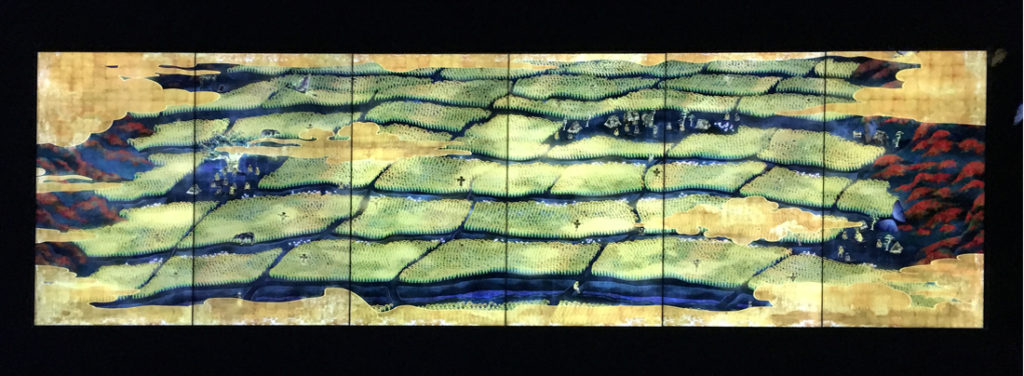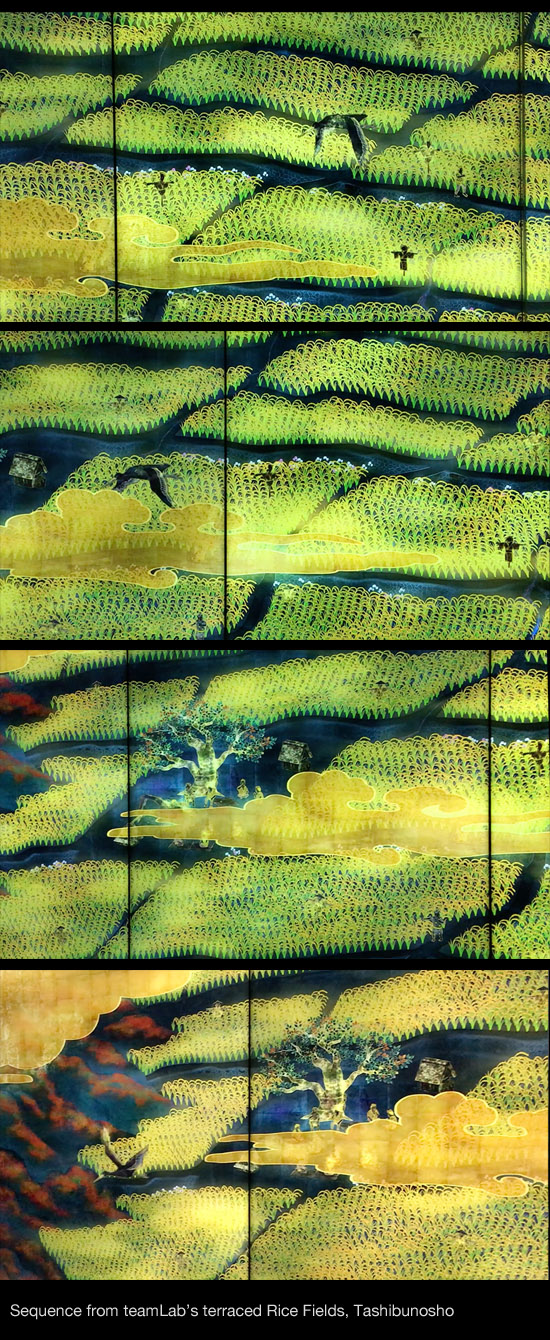Just over 10 years ago, the Living Field Project began to make a computer-based, virtual farm. A landscape was populated by crops and hedgerows, insects and mammals, tractors and people. The intention was to show how fields worked, how food was produced and how fields could not exist without the living things that make soil, vegetation and food webs. We exhibited the virtual farm at the Royal Highland Show, Edinburgh, 2008 [1] using computers and screens. Attempts to take it to the web ran out of funding a year or two later.
A farmed landscape, constructed by teamLab [2] and displayed at the Singapore ArtScience Museum [3] is a compelling example of learning by immersion in a virtual landscape. A screen on a wall in the first exhibition room depicts rice terraces on Kyushu Island, Japan.

Four Seasons, a 1000 years, Terraced Rice Fields – Tasibunosho
The display is credited – 2016, Digital Work, 6 Channels, 1000 years, Artwork by teamLab. The caption reads:
“This monitor work depicts the harmonious existence between man and nature in the famed terraced rice fields, Tashibunosho in Kyushu Island, Japan. This work is generative, with the virtual world synchronising with the actual environment on Kyushu Island – weather and timings of sun setting and rising – in real time. ‘
The observer enters the room – the detail draws you in. A man leading a bullock along a path, groups of people doing agricultural tasks or eating a communal meal, a large bird (perhaps a crane) winging slowly across the landscape, clouds passing over the scene, dissolving and generating, water flowing between the fields. And humour that should appeal to all – a big frog marching along a path. It appeals to the young – they can touch!

It is not possible to appreciate in one visit of a hour or two the changes on the monitor that must occur as days pass into seasons. teamLab explains:
“The imagery changes throughout the day; it grows brighter as the sun rises and glows with the setting sun before darkness sets in as the night deepens. Mirroring nature in many ways, the appearance of the artwork is constantly changing and no two moments are ever the same.”
There is no formal explanation of farming or food production. Yet the events witnessed are impressed on the mind. Rice crops are sown, irrigated and harvested in fields defined spatially by paths and bunds. The fields are not isolated but connected, most clearly by waterways and by farm workers with their draft animals. Nature flies or walks over or among the fields and into the surrounding low vegetative hills. The landscape is whole and connected – it is more than a set of fields.
The series of four images above left are single frames from a 30 second video taken by a phone. The video follows a large bird that casually flaps its way over the rice, each plant carefully delineated. It passes over scarecrows, overtakes a cloud. It continues past a large tree set in a clearing and around which people are seated. Finally it disappears out of the rice to the left of the monitor.
The display might provoke many points of discussion among groups of young visitors, depending on the time of year and whether rice is growing or not, for example:
- how did the plants get there and what are they for, assuming most of the visiting children will not know where food comes from (as in the UK)
- why are the fields set out in that pattern, why are they covered in water, where does the water come from – and what happens if it runs out
- what do the farm animals do
- where have the trees gone – we can only see one big one and a few smaller ones
- where does the rice go when it’s been harvested – who eats it?
- ….. and more …… (with thanks from some UK visitors for a unique experience)
Sources, links
[1] The Living Field’s Graham Begg and Gladys Wright designed and built Virtual Farm in 2007/08 for exhibition at the Royal Highland Show, Edinburgh in June 2008.
[2] teamLab’s web site gives examples of the Tashibunosho rice fields at https://www.teamlab.art/w/tashibunosho.
[3] More on the ArtScience Museum at Where art meets science: Singapore.
[4] The low-quality images here were taken by phone in the dim light of the exhibition hall and give an impression of the display. teamLab’s high res images can be see via [2].
Contact: geoff.squire@outlook.com or geoff.squire@hutton.ac.uk
